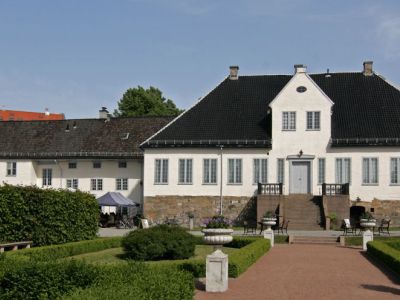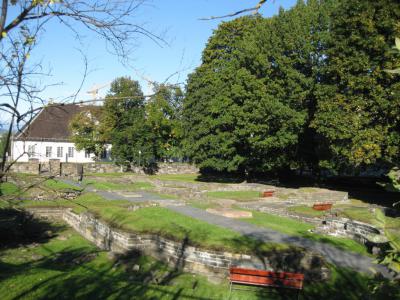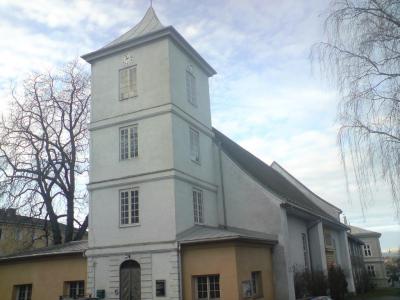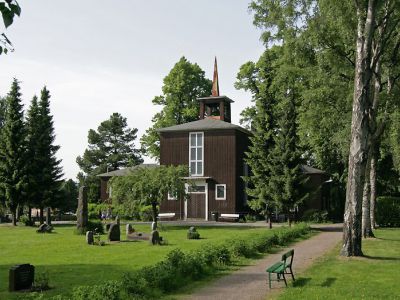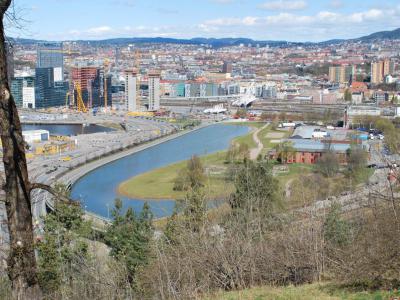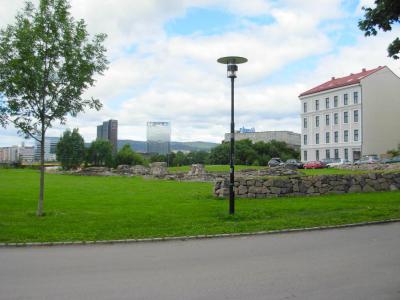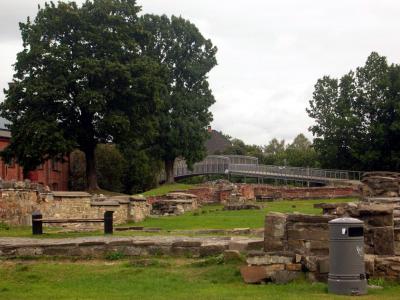Old Oslo Walking Tour (Self Guided), Oslo
The historic Old Town of Oslo is the oldest part of the city which dates back to the days of medieval Norway. This urban area emerged around the year 1000 and became the capital of Norway's dominion (within the Dano-Norwegian Realm) around 1300. The Old Town district continued to be known as Oslo, while the whole city was called Christiania, until 1925.
One of its prominent landmarks is the Oslo Manor House, a historic building that once served as the residence of the city's wealthiest citizens. Today, it stands as a symbol of the area's rich heritage.
As you wander through the Old Town, you'll come across Memorial Park (Minneparken), featuring the ancient ruins of stone and brick structures that once graced the area centuries ago. Among them are the ruins of Saint Hallvard's Cathedral.
Also notable are the Old Town's Church and Cemetery (Gamlebyen Gravlund) enabling visitors to connect with the history and lives of those who once called this area home. In the same vein, the ruins of Saint Clement's and Saint Mary's churches offer glimpses into the architectural yesteryear of Oslo.
Exploring further, you'll encounter the so-called Medieval Park (Middelalderparken). Although established only in the year 2000, this place preserves the atmosphere of the past thanks to its medieval-inspired design and historical artifacts.
In the Old Town of Oslo, the echoes of the days gone by are still heard and felt. So, whenever you're in Oslo, don't miss the opportunity to explore this remarkable corner of the capital and discover its gems firsthand. A time well spent guaranteed!
One of its prominent landmarks is the Oslo Manor House, a historic building that once served as the residence of the city's wealthiest citizens. Today, it stands as a symbol of the area's rich heritage.
As you wander through the Old Town, you'll come across Memorial Park (Minneparken), featuring the ancient ruins of stone and brick structures that once graced the area centuries ago. Among them are the ruins of Saint Hallvard's Cathedral.
Also notable are the Old Town's Church and Cemetery (Gamlebyen Gravlund) enabling visitors to connect with the history and lives of those who once called this area home. In the same vein, the ruins of Saint Clement's and Saint Mary's churches offer glimpses into the architectural yesteryear of Oslo.
Exploring further, you'll encounter the so-called Medieval Park (Middelalderparken). Although established only in the year 2000, this place preserves the atmosphere of the past thanks to its medieval-inspired design and historical artifacts.
In the Old Town of Oslo, the echoes of the days gone by are still heard and felt. So, whenever you're in Oslo, don't miss the opportunity to explore this remarkable corner of the capital and discover its gems firsthand. A time well spent guaranteed!
How it works: Download the app "GPSmyCity: Walks in 1K+ Cities" from Apple App Store or Google Play Store to your mobile phone or tablet. The app turns your mobile device into a personal tour guide and its built-in GPS navigation functions guide you from one tour stop to next. The app works offline, so no data plan is needed when traveling abroad.
Old Oslo Walking Tour Map
Guide Name: Old Oslo Walking Tour
Guide Location: Norway » Oslo (See other walking tours in Oslo)
Guide Type: Self-guided Walking Tour (Sightseeing)
# of Attractions: 8
Tour Duration: 1 Hour(s)
Travel Distance: 1.4 Km or 0.9 Miles
Author: DanaOffice
Sight(s) Featured in This Guide:
Guide Location: Norway » Oslo (See other walking tours in Oslo)
Guide Type: Self-guided Walking Tour (Sightseeing)
# of Attractions: 8
Tour Duration: 1 Hour(s)
Travel Distance: 1.4 Km or 0.9 Miles
Author: DanaOffice
Sight(s) Featured in This Guide:
- Oslo Manor House
- Minneparken (Memorial Park)
- St. Hallvard's Cathedral Ruins
- Gamlebyen Church (Old Town Church)
- Gamlebyen Gravlund (Old Town's Cemetery)
- Middelalderparken (Medieval Park)
- St. Clement's Church Ruins
- St. Mary's Church Ruins
1) Oslo Manor House
Oslo Manor House is located in Oslo’s medieval quarter. Rapid urban development in the 20th century caused the area to become neglected, with main roads cutting through it, and buildings falling into disrepair. After a major period of restoration, today the area is a popular tourist destination, with newly renovated buildings like the Manor House offering a glimpse into life in the bygone ages of Norway.
Oslo Ladegard, as it is known locally, dates from 1720. It is found in the heart of the medieval center of Oslo, at the foot of Ekeberg Hill. A baroque manor house, it was built over the cellar of the nearby Bispeborgen building. The newly restored interior features paintings, furniture and decoration from different artistic eras. In the house’s former attic, you can find scale models of Oslo in medieval times, and an exhibition on burial rites in the Middle Ages.
The manor house is open to guided group tours throughout the year, although these need to be pre-booked. Tours without reservation run during the summer season, but are carried out in Norwegian only. The grounds host an al fresco café in the summer months, as well as open air concerts on Wednesdays throughout the year.
Oslo Ladegard, as it is known locally, dates from 1720. It is found in the heart of the medieval center of Oslo, at the foot of Ekeberg Hill. A baroque manor house, it was built over the cellar of the nearby Bispeborgen building. The newly restored interior features paintings, furniture and decoration from different artistic eras. In the house’s former attic, you can find scale models of Oslo in medieval times, and an exhibition on burial rites in the Middle Ages.
The manor house is open to guided group tours throughout the year, although these need to be pre-booked. Tours without reservation run during the summer season, but are carried out in Norwegian only. The grounds host an al fresco café in the summer months, as well as open air concerts on Wednesdays throughout the year.
2) Minneparken (Memorial Park)
Minneparken is a spot in Oslo that should not be missed by anyone who is interested in archaeology and medieval ruins. Minneparken is the site of ruins from three 12th century buildings: Saint Hallvard's Cathedral, Holy Cross Church and Saint Olav's Monastery.
Saint Hallvard's Cathedral is notable as the first cathedral in the city. It was built in the early 12th century and later used as the coronation church and royal wedding church. Excavation commenced on the ruins in 1865. However, excavation wasn't completed until early 1920s when Gerhard Fischer took over.
Saint Olav's Monastery was a Dominican order monastery that was established in the 12th century. Excavation began on the monastery in 1914 and was completed in 1926 by Fischer. It is said to be the best-preserved monastery in Norway. Visitors are welcome to enter Saint Olav's as part of a guided tour.
The least is known about Holy Cross Church. It is believed to be constructed prior to 1240.
Saint Hallvard's Cathedral is notable as the first cathedral in the city. It was built in the early 12th century and later used as the coronation church and royal wedding church. Excavation commenced on the ruins in 1865. However, excavation wasn't completed until early 1920s when Gerhard Fischer took over.
Saint Olav's Monastery was a Dominican order monastery that was established in the 12th century. Excavation began on the monastery in 1914 and was completed in 1926 by Fischer. It is said to be the best-preserved monastery in Norway. Visitors are welcome to enter Saint Olav's as part of a guided tour.
The least is known about Holy Cross Church. It is believed to be constructed prior to 1240.
3) St. Hallvard's Cathedral Ruins
Saint Hallvard's Cathedral, also known as Hallvardskatedralen, was once the revered cathedral of Oslo. However, by the 17th century, it had fallen into disrepair and now stands as a collection of ruins. This historical site is situated within the confines of Old Town Oslo.
Originating in the early 12th century, the cathedral bore witness to Oslo's transformation. Following a catastrophic fire in 1624, Oslo was forsaken, leading to the establishment of a new city, Christiania, approximately a kilometer westward. Saint Hallvard's Cathedral retained its role as a church until around 1655. Over a span of about five centuries, it served as the religious hub and episcopal seat for eastern Norway. The cathedral played host to coronations, royal weddings, and other regal ceremonies, solidifying its place as a pinnacle of significance in Scandinavia and a sought-after pilgrimage site.
The southern vicinity of the cathedral houses Saint Hallvard cemetery, an esteemed burial ground from approximately 1130 to 1639, reserved for bishops, notable individuals, and even Norwegian monarchs from Oslo and the eastern reaches of the country.
The initial exploration of the cathedral's remains occurred in 1865, undertaken by Norwegian archaeologist Nicolay Nicolaysen. Regrettably, sections of the ruins were lost during the construction of the Ostfold Rail Line in the early 1920s. Nevertheless, in 1932, the cathedral remained a focal point upon the inauguration of Memorial Park in Old Town (Minneparken i Gamlebyen). Nestled adjacent to the cathedral's remnants are the vestiges of the medieval parish church, Holy Cross Church (Korskirken).
Originating in the early 12th century, the cathedral bore witness to Oslo's transformation. Following a catastrophic fire in 1624, Oslo was forsaken, leading to the establishment of a new city, Christiania, approximately a kilometer westward. Saint Hallvard's Cathedral retained its role as a church until around 1655. Over a span of about five centuries, it served as the religious hub and episcopal seat for eastern Norway. The cathedral played host to coronations, royal weddings, and other regal ceremonies, solidifying its place as a pinnacle of significance in Scandinavia and a sought-after pilgrimage site.
The southern vicinity of the cathedral houses Saint Hallvard cemetery, an esteemed burial ground from approximately 1130 to 1639, reserved for bishops, notable individuals, and even Norwegian monarchs from Oslo and the eastern reaches of the country.
The initial exploration of the cathedral's remains occurred in 1865, undertaken by Norwegian archaeologist Nicolay Nicolaysen. Regrettably, sections of the ruins were lost during the construction of the Ostfold Rail Line in the early 1920s. Nevertheless, in 1932, the cathedral remained a focal point upon the inauguration of Memorial Park in Old Town (Minneparken i Gamlebyen). Nestled adjacent to the cathedral's remnants are the vestiges of the medieval parish church, Holy Cross Church (Korskirken).
4) Gamlebyen Church (Old Town Church)
Gamlebyan Church, also known as Old Town Church, is a private church that is part of Oslo University Hospital. The church was built on the foundation of a Franciscan monastery that dates to 1290. However, the building itself was completed much later in 1796 using the Louis XVI architectural style.
The church has not been in use since 2014. This is partially due to the fact that it is aged, but also that it only has seating for 200 people. It may be difficult to gain entry into the church to see the inside. However, it is worth walking by the Old Town Church to see the church and the medieval ruins on which it was built. Those who can take a look inside will see the suspended pulpit, which was added in the 19th century.
Gamlebyan Church is located in Gamle Oslo, or Old Oslo. Visitors can explore many of the Old Town landmarks and relics while touring the area on foot. Some of these include Minneparken, Middlealderparken, Kongsgarden and the Ruins of Cleminskirken.
The church has not been in use since 2014. This is partially due to the fact that it is aged, but also that it only has seating for 200 people. It may be difficult to gain entry into the church to see the inside. However, it is worth walking by the Old Town Church to see the church and the medieval ruins on which it was built. Those who can take a look inside will see the suspended pulpit, which was added in the 19th century.
Gamlebyan Church is located in Gamle Oslo, or Old Oslo. Visitors can explore many of the Old Town landmarks and relics while touring the area on foot. Some of these include Minneparken, Middlealderparken, Kongsgarden and the Ruins of Cleminskirken.
5) Gamlebyen Gravlund (Old Town's Cemetery)
Gamlebyan Gravlund is adjacent to Gamlebyan Church, or Old Town Church. The cemetery is sometimes known as Oslo Hospital Cemetery due to the fact that the graveyard, like Gamlebyan Church, is owned by the hospital.
The cemetery is still in use with the oldest graves dating to the early 1800s. The cemetery includes a field of sailor's graves, graves for railway employees and a Muslim burial field in which all graves face Mecca. The cemetery includes a field and monument for those who have been cremated. The oldest grave at Gamlebyan belongs to Barbara Margarethe Brockmann Schnitlek who passed away on May 1, 1829. The majority of the graves began appearing in the late 19th century and continue being placed through present day.
Visitors are welcome to walk respectfully through the graveyard if they wish. It has a large walking path that is shaded by mature trees, which provide a nice break from the traffic on nearby Dyvekes vei.
The cemetery is still in use with the oldest graves dating to the early 1800s. The cemetery includes a field of sailor's graves, graves for railway employees and a Muslim burial field in which all graves face Mecca. The cemetery includes a field and monument for those who have been cremated. The oldest grave at Gamlebyan belongs to Barbara Margarethe Brockmann Schnitlek who passed away on May 1, 1829. The majority of the graves began appearing in the late 19th century and continue being placed through present day.
Visitors are welcome to walk respectfully through the graveyard if they wish. It has a large walking path that is shaded by mature trees, which provide a nice break from the traffic on nearby Dyvekes vei.
6) Middelalderparken (Medieval Park)
Middelalderparken is a park worthy of any Oslo walking tour. The park is known as the Medieval Park, which may seem ironic in that it wasn't opened until the year 2000. It gains its name not from the history of the park itself but for the landmarks that are located within.
The 43-acre park offers 22 acres of water, plenty of green space and the Ekorn hangout wildlife refuge. Most notable within Medieval Park are the three medieval ruins: Saint Clement's Church, Saint Mary's Church and Oslo Kongsgard.
Like many of the medieval ruins of Oslo, Saint Clement's Church was excavated by Gerard Fischer. The stone church is thought to have been built around the year 1100. However, more than 80 burials were discovered beneath the church that have been carbon dated to the year 980. These burials are believed to be some of the oldest Christian burials in Norway.
Saint Mary's Church was a stone church, possibly built in the 1200s, which was preceded by wooden, stave church constructed around the year 1050. During excavation, the remains of King Haakon V and Queen Consort Euphemia of Rugen were found. Those remains were removed to Akershus Fortress.
Oslo Kongsgard was the 11th century royal residential palace. It served in this capacity until Akershus Fortress was built.
The 43-acre park offers 22 acres of water, plenty of green space and the Ekorn hangout wildlife refuge. Most notable within Medieval Park are the three medieval ruins: Saint Clement's Church, Saint Mary's Church and Oslo Kongsgard.
Like many of the medieval ruins of Oslo, Saint Clement's Church was excavated by Gerard Fischer. The stone church is thought to have been built around the year 1100. However, more than 80 burials were discovered beneath the church that have been carbon dated to the year 980. These burials are believed to be some of the oldest Christian burials in Norway.
Saint Mary's Church was a stone church, possibly built in the 1200s, which was preceded by wooden, stave church constructed around the year 1050. During excavation, the remains of King Haakon V and Queen Consort Euphemia of Rugen were found. Those remains were removed to Akershus Fortress.
Oslo Kongsgard was the 11th century royal residential palace. It served in this capacity until Akershus Fortress was built.
7) St. Clement's Church Ruins
Saint Clement's Church, formerly one of Oslo's Roman Catholic parish churches, now stands as ruins within the Medieval Park. Dedicated to Saint Clement, a 1st-century pope and patron saint of seafarers due to his martyrdom by drowning with an anchor around his neck, this stone church featured a distinctive double-nave floor plan and a tower. The entrances graced its southern and western facades, while the central choir axis boasted three supporting pillars for the roof. As the tides of the Protestant Reformation swept in, the church fell into disuse and likely met its end in 1540.
Architect Gerhard Fischer uncovered and surveyed the ruins in 1921, though their significance remained largely overlooked for years. In the years 1970–71, archaeologist Ole Egil Eide undertook further excavations beneath the church's foundations. His work unveiled a wealth of history, including 81 ancient burials predating the stone church. These graves were organized into seven distinct layers beneath the church.
Beneath a layer of sand, Eide's exploration revealed another 60 graves. His assessment suggests the presence of not just one, but possibly two earlier churches – potentially stave churches – preceding the construction of the stone church around 1100. Radiocarbon dating pinpointed the oldest burials to roughly 980-1030, presenting some of Norway's earliest Christian interments.
Architect Gerhard Fischer uncovered and surveyed the ruins in 1921, though their significance remained largely overlooked for years. In the years 1970–71, archaeologist Ole Egil Eide undertook further excavations beneath the church's foundations. His work unveiled a wealth of history, including 81 ancient burials predating the stone church. These graves were organized into seven distinct layers beneath the church.
Beneath a layer of sand, Eide's exploration revealed another 60 graves. His assessment suggests the presence of not just one, but possibly two earlier churches – potentially stave churches – preceding the construction of the stone church around 1100. Radiocarbon dating pinpointed the oldest burials to roughly 980-1030, presenting some of Norway's earliest Christian interments.
8) St. Mary's Church Ruins
Saint Mary's Church, situated in Oslo, was a medieval place of worship. The remnants of this church now lie within the Medieval Park (Middelalderparken) near the Sørenga neighborhood, which is part of the Gamlebyen borough.
Constructed gradually in stages from stone, Saint Mary's Church underwent its final enhancements in the 14th century. An extensive renovation during the 1200s introduced a new Gothic choir to the church's architecture. A significant reconstruction in the 1300s expanded the church with two imposing towers on its western side and a spacious cruciform choir. The church held a dual role as the royal chapel and a key player in political affairs, with its provost concurrently serving as Norway's Chancellor since 1314. Unfortunately, in 1523, the church fell victim to a fire sparked by the Swedish War of Independence against the Kalmar Union. Post the Protestant Reformation, its condition deteriorated to the point where restoration was infeasible, leading to its demolition in 1542.
Archaeological excavations commenced in 1867, led by Nicolay Nicolaysen under the supervision of Gerhard Fischer. Further excavations took place during the 1960s, led by Håkon Christie. Among the findings were remnants of an older wooden structure that Håkon Christie dated back to approximately 1050. Amidst the church ruins, the remains of two individuals were discovered and identified as King Haakon V and his Queen consort Euphemia of Rügen. These remains were subsequently re-interred in the Royal Mausoleum located within Akershus Castle.
Interestingly, the territory now occupied by the Norwegian Crown Prince Residence of Skaugum in the Asker municipality originally formed a part of the Saint Mary's Church's domain.
Constructed gradually in stages from stone, Saint Mary's Church underwent its final enhancements in the 14th century. An extensive renovation during the 1200s introduced a new Gothic choir to the church's architecture. A significant reconstruction in the 1300s expanded the church with two imposing towers on its western side and a spacious cruciform choir. The church held a dual role as the royal chapel and a key player in political affairs, with its provost concurrently serving as Norway's Chancellor since 1314. Unfortunately, in 1523, the church fell victim to a fire sparked by the Swedish War of Independence against the Kalmar Union. Post the Protestant Reformation, its condition deteriorated to the point where restoration was infeasible, leading to its demolition in 1542.
Archaeological excavations commenced in 1867, led by Nicolay Nicolaysen under the supervision of Gerhard Fischer. Further excavations took place during the 1960s, led by Håkon Christie. Among the findings were remnants of an older wooden structure that Håkon Christie dated back to approximately 1050. Amidst the church ruins, the remains of two individuals were discovered and identified as King Haakon V and his Queen consort Euphemia of Rügen. These remains were subsequently re-interred in the Royal Mausoleum located within Akershus Castle.
Interestingly, the territory now occupied by the Norwegian Crown Prince Residence of Skaugum in the Asker municipality originally formed a part of the Saint Mary's Church's domain.
Walking Tours in Oslo, Norway
Create Your Own Walk in Oslo
Creating your own self-guided walk in Oslo is easy and fun. Choose the city attractions that you want to see and a walk route map will be created just for you. You can even set your hotel as the start point of the walk.
Grunerlokka Walking Tour
Once a gritty, working-class corner of Oslo, Grunerlokka has undergone the classic glow-up-trading in factory soot for flat whites and vegan tacos. Named after Friedrich Gruner, a 17th-century city official who probably never imagined his name would one day grace a district with more tattoo parlors than churches, this neighborhood has turned from industrial to the capital’s cool kid on the block... view more
Tour Duration: 1 Hour(s)
Travel Distance: 2.5 Km or 1.6 Miles
Tour Duration: 1 Hour(s)
Travel Distance: 2.5 Km or 1.6 Miles
Museum District (Bygdoy) Walking Tour
Oslo's Museum District, located on the Bygdoy Peninsula, is home to some of the most visited museums in the city. Repositories of precious artifacts from Norway’s history, these remarkable institutions collectively represent a treasure trove for those keen on exploring this northerly nation's past.
One of the standout attractions here is the Fram Museum, showcasing the incredible... view more
Tour Duration: 2 Hour(s)
Travel Distance: 3.1 Km or 1.9 Miles
One of the standout attractions here is the Fram Museum, showcasing the incredible... view more
Tour Duration: 2 Hour(s)
Travel Distance: 3.1 Km or 1.9 Miles
Oslo Introduction Walking Tour
Originally a Viking village, Norway's capital city has a long and multifaceted history that begins long before its establishment as a trading hub of Ánslo in 1040 AD. Archaeological findings suggest the presence of a Christian settlement in the area predating the year 1000.
Throughout the Middle Ages, Oslo's significance varied under the rule of Danish and Norwegian kings. Around... view more
Tour Duration: 2 Hour(s)
Travel Distance: 4.1 Km or 2.5 Miles
Throughout the Middle Ages, Oslo's significance varied under the rule of Danish and Norwegian kings. Around... view more
Tour Duration: 2 Hour(s)
Travel Distance: 4.1 Km or 2.5 Miles
Historical Churches Walking Tour
Oslo's religious landscape, particularly within the Christian tradition, is a captivating tapestry interwoven with history, faith, and architectural elegance. The city boasts a collection of historical churches reflecting the evolution of local Christian communities. Diverse in their designs, these sacred sites offer a glimpse into the deep-rooted religious traditions that have shaped Oslo... view more
Tour Duration: 1 Hour(s)
Travel Distance: 1.2 Km or 0.7 Miles
Tour Duration: 1 Hour(s)
Travel Distance: 1.2 Km or 0.7 Miles
Useful Travel Guides for Planning Your Trip
Traveler's Choice: 15 Norwegian Gifts from Oslo
The Norwegians are strict about gift making and believe that each gift must be equaled with a return one. For this reason, public holidays and birthdays are a very serious business in Norway, with everyone making and receiving gifts. In the spirit of this tradition, you might want to treat your dear...
The Most Popular Cities
/ view all



